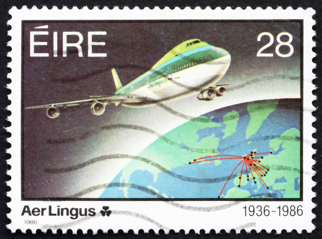INSIDE THE DEAL
A spectacular takeoff and a crash landing: the story of GPA
Last month, European regulators approved a €25bn deal between Ireland’s AerCap to buy GE Capital Aviation Services in a move that sees the world’s two largest aviation leasing companies join forces. Katherine Muir looks at the beginnings of aircraft leasing in Ireland with the birth of Guinness Peat Aviation, a brokering venture set up in the 1970s which put Ireland at the centre of the air finance industry and in which both AerCap and GECAS have their origins.
Credit: Peter Krocka / Shutterstock.com
Guinness Peat Aviation is one of leasing’s great cautionary tales, an aircraft leasing company that was built from scratch, becoming one of Ireland’s biggest companies in the space of 15 years. In the 1980s GPA ruled the skies but its plans to float the company went disastrously off course ending in financial collapse and later restructuring by GE Capital. The company’s founder, Tony Ryan, went on to have further success with Ryanair, which became Europe’s largest airline.
GPA was founded in the 1970s by Ryan, then an Aer Lingus manager, who was responsible for looking for alternative business uses for the national carrier’s planes during the downturn that followed from The Troubles and the oil shock of 1973. He orchestrated a deal for Aer Lingus with Air Siam, providing a fully crewed Boeing 747 jumbo jet.

Credit: Shutterstock.com
In 1974 he set up GPA with just £5,000 of his own money and the support of Aer Lingus and financing from the merchant bank, Guinness Peat. The company, operating out of Shannon, started off with one second-hand Boeing 737 following a leasing model that worked with second-tier airlines to defray the costs of buying expensive aeroplanes.
The business soared, and by 1991 they had a turnover of more than $2bn and at its peak it was valued at $4bn and was reportedly buying a plane a week. By then Air Canada had taken a third share in GPA although Ryan remained very much in control with an 8 percent stake in the company.
Then in 1992 came GPA’s spectacular collapse, downed by its decision to float the company in the wake of a recessionary downturn following the first Gulf War. Despite an impressive cast of celebrity board members that included former taoiseach Garret FitzGerald, ex-British chancellor Nigel Lawson, industrialist and TV business troubleshooter Sir John Harvey-Jones and the Irish businessman and politician Peter Sutherland, not to mention the great media fanfare that surrounded the float, the financial community, nervous about recession and with little understanding of the business, baulked at the price and at the last minute it did not go ahead.
In the aftermath of the IPO failure the spotlight was turned on the GPA’s high debt levels and confidence in the company disappeared. General Electric swooped in to pick up the pieces although many of the management team stayed on. It was eventually largely sold on to Debis AirFinance (part of Daimler Chrysler) in 2000, with Ryan reportedly making $50m from the sale.
GPA’s legacy has been the Irish dominance of the aircraft leasing industry for more than four decades, due to a combination of local expertise built up by GPA and favourable corporate tax rates, although in recent years their supremacy has been challenged by rivals, such as Singapore and Amsterdam.
In late July, the company’s ultimate successor AerCap, whose headquarters are in Dublin, had their $30bn (€25bn) deal to buy General Electric’s plane leasing business GECAS approved by the EU’s anti-trust regulator, doubling the size of the company, which was already the world’s largest aircraft lessor. Both AerCap and GECAS emerged from the wreckage of GPA.
The stock market was initially sceptical about the deal, AerCap’s US-traded shares sank 4.7 per cent the day after the deal was announced (from $57.53 to $53.39), although they shortly recovered some value. At the end of July AerCap was trading at $53.00.
The deal sees GE get about $24bn in cash, 111.5m ordinary shares equivalent to approximately 46 per cent ownership in the new merged company, a stake valued at about $6bn, as well as $1bn paid in AerCap notes and/or in cash upon closing. GE will transfer about $34bn in net assets to AerCap along with more than 400 employees. The deal is expected to be completed in 2022.
In March, Fitch placed AerCap's credit rating on review for a possible downgrade, citing the new debt taken on by the company as well as the continuing uncertainty of the pandemic given that one-third of the combined company’s fleet is currently grounded, Bloomberg.com reported. The news agency also said it had learned that AerCap may not have locked in interest rates on the debt the company will raise to complete the acquisition. AerCap’s CFO has told investors the debt raising will be funded primarily by unsecured debt.
AerCap has already shown some talent in raising funds from the capital markets in the face of a retreating banking sector. AerCap was the first of the aviation lessors to return to the bond markets in the wake of the Covid crisis, since then investment-grade lessors have shown a remarkable ability to raise unsecured debt at reasonable rates, according to Joe O’Mara, the head of aviation finance at KPMG.
The pandemic has been catastrophic for the airline industry in general – as Dómhnal Slattery, head of rival aircraft lessor Avolon (who cut his teeth at GPA) told The Times last year: “This was no black swan event. This was a swarm of black swans.” And a return to pre-Covid levels of air travel so far remains elusive. The International Air Transport Association (IATA) estimates that international travel will reach 34 per cent of 2019 levels by the end of 2021.
Against this background Aengus Kelly, the chief executive of AerCap, will be banking on a successful global vaccine rollout, unchecked by renewed waves of Covid and new variants of the virus.